November 10, 2010
 - Journey to this system to see what life would be like
Take a journey to the beginning of the universe and view exo-planets that might be more like death-planets for humans
 - You might find life to be a little harder here
Planets circling twin stars close in proximity could be a real tough place for life to begin, according to the conclusions of a study conducted using data from NASA's Spitzer Space Telescope. Space scientists using NASA's infrared observatory recently found what they believe to be clouds of possible dust around three mature, close orbiting binary stars. Dust that scientists think is possibly the result of the planets orbiting these twin stars colliding, which could make living on these planets difficult for any lifeforms that might have arisen on these planets.
Planetary collisions are possible real-life science fiction in action, as the reasons for the dust clouds are certainly a matter of conjecture, and something that any science fiction writer is going to be able to spin a tale of annihilation around. Lifeforms evolving under the environmental conditions that possibly exist on planets orbiting binary stars of the particular class studied would certainly be something beyond the imagination of any human writer. It's unlikely that anything we humans create using our imaginations could ever match the possibilities that exist in space and time. The finite imaginations of humans is limited by our senses, experiences and of course the limits of what we refer to as our human perception or intelligence to some.
Lifeforms evolving on these planets would have to survive possible planetary collisions at regular intervals, if space scientists conclusions are correct? If they have the ability to sense the world beyond their normal lives? Lifeforms existing on these planets could be non-sentient and unable to perceive the annihilation above them. They could be looking up at annihilation coming toward them in the form of another planets, asteroid, or other celestial body orbiting the binary star systems in question. They may have been destroyed in a recent collision between planets and are space dust, once again. The view would be a spectacular one though, with two huge suns that would exceed anything we experienced viewing the double stars systems in the Star Wars Saga.
Life evolving on planets circling binary stars like the ones in question would have a limited time to evolve into a space traveling sentient race as well. The suns in the binary star system they have evolved on are slowly circling closer and closer, according to astronomers, which could possibly make surviving and evolving on these planets a lot more difficult. Lifeforms surviving and thriving on these planets would likely be a survivor beyond human imagination, so we should probably thank our lucky stars that they aren't likely to be stopping by for a visit, anytime soon.
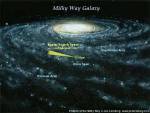 - We have a lot of places to look for new planets suitable for human life. Guess we better get started.
Posted by Warren Wong. Posted In : exo-planets
November 9, 2010
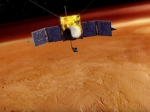 - An artists conception of MAVEN in orbit around Mars. NASA photos.
Where did Mar's thicker atmosphere go?
 - This shot shows water ice clouds at the top that indicate a storm front on the Red Planet
Space scientists looking at the atmosphere of the Red Planet have a bit of a mystery on their hands as the facts would seem to indicate that Mars should have a much more prominent atmosphere. The formation of an atmosphere thick enough for liquid water to flow on the planet's surface would have made the Red Planet a very promising place for the formation of life in our solar system. Planet scientists that have been studying Mars and the data collected by instruments they have focused on the Red Planet and are planning on journeying to the Red Planet to delve into the mystery of Mar's atmosphere using MAVEN (Mars Atmosphere and Volatile Evolution Mission), sometime in the future. They want to see if they can find any clues as to where Mar's atmosphere might have gone and the possibly reasons it's no longer present on Mars. They also want to see if they can determine a timeline for the disappearance of the Red Planet's thick atmosphere, which could give them an idea whether Mar's had time to develop life of any form.
Planet scientists looking at the surface of Mars see features that leads them to believe that the surface of the Red Planet has been a cold and barren place for billions of years. This is hardly the environment for Earth-based life to develop, but surface features resembling water-channels of some kind and minerals scientists know will form in the presence of water have been found on the surface of Mars. These facts lead planet scientists to the possibility that Mars once had a much thicker atmosphere and was warm enough for liquid water to flow along the surface of Mars. The only problem is Mars currently has a very thin atmosphere unable to protect any liquid water that forms on the surface of Mars from the radiation of the sun and consequently any water would have been scoured from the planet's surface, long ago. This environment would be the end-of-the-road for any known Earth-based life form, but it's possible any Martian life forms that existed during the time when Mar's thicker atmosphere went missing could have decided to go underground in order to survive. NASA plans on sending MAVEN out to the Red Planet to see if they can find any clues to the mystery of where Mar's thicker atmosphere went, sometime in 2013, if NASA's current plans stay on target.
What are the possible reasons Mar's no longer has a much thicker atmosphere? Space scientists at this point believe that Sol could be the main culprit in the disappearance of the Red Planet's atmosphere, that Sol's breath, or solar wind, is the possible force responsible for Mars no longer having a much thicker atmosphere possibly capable of supporting Earth-based life. They think it's possible the electrically charged ions and electrons in the solar wind could have slowly stripped away Mar's thicker atmosphere in its early days, after Mars lost its global magnetic field, which would have normally shielded the thicker atmosphere of the Red Planet from the force of Sol's solar wind, just as Earth's global magnetic field protects our atmosphere from the solar wind. Sol's solar wind isn't the only possibly culprit in the disappearance of Mar's thicker atmosphere and NASA's planning on sending MAVEN to the Red Planet within the next two years to take a look at what remains of the upper atmosphere of Mars, the ionosphere and the way the atmosphere of the Red Planet interacts with Sol and its solar wind.
Posted by Warren Wong. Posted In : Mars missions
November 6, 2010
 - Television and the universe will never be the same
 - Did the universe begin in the biggest bang of them all?
The "Big Bang Theory" Hits Home
Ever heard of the "Big Bang Theory", the television show starring Johnny Galecki and Jim Parsons as two nerdy physicists being taught the meaning of a big bang by the sexy and memorable Kaley Cuoco as Penny. We'll astronomers have a theory about the biggest bang of them all, they call the "Big Bang". A theory about the beginning of space and time and the reasons the universe you'll experience during your journey to the beginning of the universe is expanding and continuing to expand, astronomers "Big Bang" theory is the best theory humans have conceptualized, so far, to explain the beginning of the universe and the things humans experience during our journey to the beginning of the universe.
The discovery of the expanding universe by Edwin Hubble in the 1920s led to the conclusion by astronomers and scientists that the universe must once have been much closer together, and fundamentally changed the way astronomers view the universe and space and time as possible proof of the "Big Bang". Did the universe begin in an instant of space and time in a cosmic event we refer too as the "Big Bang"? Modern astronomers are currently using the latest technology and biggest telescopes ever engineered and built by mankind to journey backward in time to the moments just before the birth of the universe to look for clues to answers to this question. The Hubble Space Telescope and soon to be launched James Webb Space Telescope will form a team of astronomical instruments that will help astronomers look backward to a time just before the "Big Bang" would have occur, if present theories are correct. At present, astronomers have only journeyed backward to a time about 1 or 2 billion years before this supposed, "Big Bang", but they expect to travel farther backward to a time closer to the Big Bang, once the James Webb Space Telescope is up and running around 2014 or 2015, according to the latest estimates by NASA.
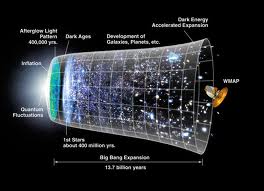 - Astronomers are planning to journey back to the beginning of space and time to see if they can prove this Big Bang really happened
Posted by Warren Wong. Posted In : Star Astronomy
November 5, 2010
Star gazers Halloween treats abound in autumn's night sky
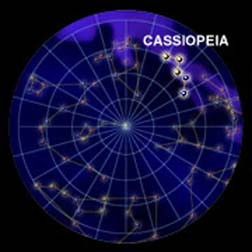 - This star map gives you an idea of the stars in and around Cassiopeia the Queen. NASA photos.
Cassiopeia the Queen is one of the first northern deep sky objects we'll view during our journey to the beginning of the universe. Cassiopeia the Queen is easily recognizable in autumn's night sky using her characteristic W or M shape form and she was one of the 48 constellations originally listed by the 2nd century Greek astronomer Ptolemy during his observations of the night sky. Today, Cassiopeia the Queen is one of 88 constellations recognized by modern star gazers in the night sky, and the abundance of magnificent open star clusters within her arms provides viewers with a chance to see a variety of outstanding celestial objects that have been entertaining star gazers for thousands of years.
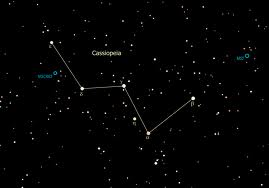 - Five stars outline Cassiopeia's characteristic W shape
Cassiopeia the Queen is a familiar sight for modern astronomers and star gazers in the mid-northern latitudes of planet Earth, and is often one of the first constellations in the northern sky beginning star gazers journey to view. Board your time-machine-to-the-stars near the end of October, or the beginning of November, and take the family on a journey through time and space to visit Cassiopeia the Queen. A visit with Cassiopeia the Queen will open a child's mind to the possibilities of the universe, before them, and your wife will be able to tell her friends that you took her out last night.
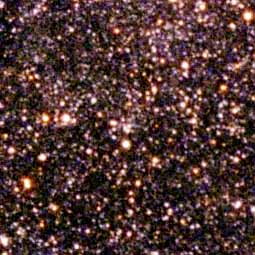 - 8x50 astronomical binoculars will reveal about 12 stars nestled in among the collective glow of other stars to faint to resolve
One of the best open star clusters you can view with the naked eye is 6.5 magnitude NGC 129, a large, bright, open cluster of stars 8x50 astronomical binoculars will reveal to have six to twelve brighter stars nestled within the collective glow of a field of stars to faint to resolve using binoculars. You should see about 35 celestial bodies in this region of space and time 5,200 light years distant from your position on the Earth. Look toward the north of two 9th magnitude stars, near the center of NGC 129, and you'll find the Cepheid variable DL Cassiopeiae. DL Cassiopeiae will fluctuate between 8.6 and 9.3 magnitude, over the course of an eight-day cycle.
The central star in Cassiopeia's characteristic W is Gamma Cassiopeiae, a prototype for a class of irregular variable stars believed to be rapidly spinning type-B celestial bodies often fluctuating by as much as magnitude 1.5 or more, Gamma Cassiopeiae will flicker between 2.2 and 3.4 magnitude as you watch her nightly dance and this star at maximum brightness outshines both Alpha Cassiopeiae and Beta Cassiopeiae. Astronomers believe these apparent fluctuations are due to a decretion disc around this star resulting from the rapid spinning of the star, which results in some of the star's mass forming a decretion disc. Gamma Cassiopeiae is also a spectroscopic binary star with an orbital period of about 204 days and astronomers believe Gamma Cassiopeiae's companion star is about the same relative mass as Sol. Part of a small group of stellar sources in the night sky that beam of X-ray radiation about 10 times higher than the X-rays emitted from other type-B stars across the cosmos, Gamma Cassiopeiae exhibits both short-term and long-term cycles of x-ray emission. Star gazers should also be able to view Gamma Cassiopeiae as an optical double star, with a faint magnitude 11 companion star, about 2 arc seconds distant from Gamma Cassiopeiae.
Ancient star gazers in China called Gamma Cassiopeiae Tsih, which loosely translates as "the whip", but no references have been found in Arabic or Latin texts of Gamma Cassiopeiae being referred too using a different name. Modern star gazers refer to Gamma Cassiopeiae by a number of different designations, including 27 Cassiopeiae, HR 264, HD 5394, and others. Modern astronauts often use Gamma Cassiopeiae as a star-guide because it's a relatively bright celestial object and in previous space missions this star was used as an easily recognizable navigational reference point in the night sky.
 - M103 (NGC 581) will reveal about 25 magnitude 10 or fainter stars
M103 (NGC 581) is the first of two Messier objects in Cassiopeia's arms viewable through a six-inch time-machine-to-the-stars and should appear as about three dozen stars grouped in a triangular area 6' across. A fairly compact open cluster, M103 will be 1 degree east of Delta Cassiopeiae, and is the left bottom star of Cassiopeia's characteristic W shape marking her throne in the night sky. Pierre Mechain was first given credit for seeing this open cluster in the night sky in 1781. Star gazers using 8x50 binoculars will see about 25 magnitude 10 or fainter stars in their view and a string of four stars immediately to M103's southeast, which adds to the beauty of viewing M103, significantly.
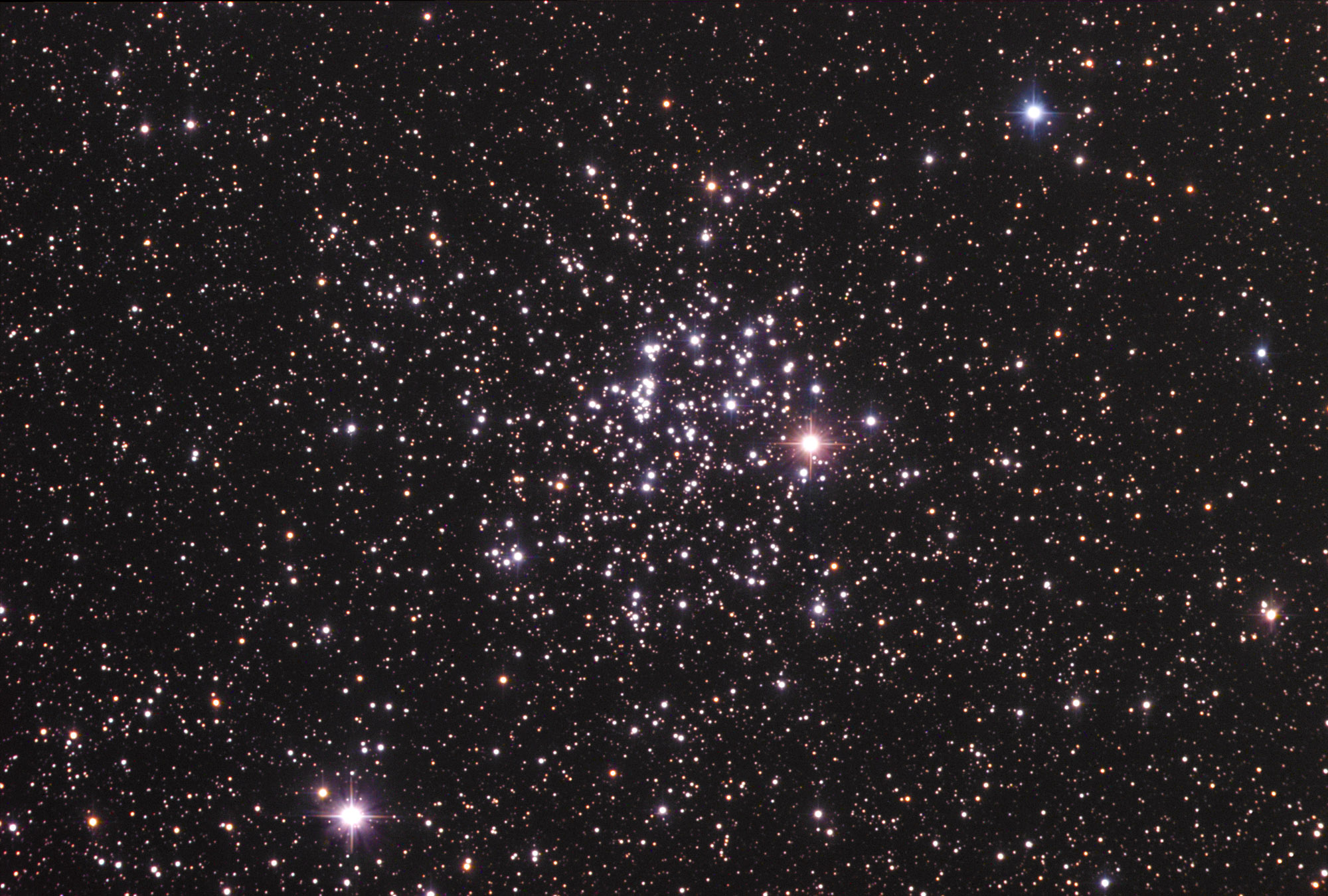 - M 52 (NGC7654) is one of the richest open clusters to view north of the celestial equator
The second Messier object in Cassiopeia catalogued by Messier is M52 (NGC 7654), you can locate M52 by drawing a line from Alpha Cassiopeiae through Beta Cassiopeiae, and then extending your line an equal distance to M52. An 8-inch time-machine-to-the-stars will reveal about 75 stars in the night sky clumped in various patterns along the edge of the Milky Way that aren't lost among the background points of light behind these stars. One of the richest open clusters in Cassiopeia's arms and north of the celestial equator, Messier made note of M52 in his catalogue in 1774. This open cluster will appear as a nebulous mass of about 100 stars in 8x50 astronomical binoculars, with a few individual stars that you can resolve a little better. Star gazers looking for a little extra should look to the north of M52 to find Harrington 12, a wide triangular looking asterism containing about a dozen 5th to 9th magnitude stars, which will appear spectacular in low-power astronomical binoculars.
Journey less than 3 degrees south of Delta Cassiopeiae to find the spectacular Owl Cluster (NGC 457), a celestial object ancient star gazers could plainly see in the north night sky, the Owl Cluster's wings will be clearly viewable using a 4-inch time-machine-to-the-stars. Star gazers can also locate Delta Cassiopeiae by using 5th magnitude Phi Cassiopeiae and 7th magnitude HD 7902, which lie to the southeast of the Owl Cluster. The Own's eastern wing is a line of four bright stars, while the western wing is composed of two pairs of stars arranged in a long rectangle. The brightest star in the Owl Cluster will shine at 8.6 magnitude and will appear a little orange in color in star gazers.
Posted by Warren Wong. Posted In : Star Astronomy
November 5, 2010
Astronomers are looking at NGC 3982 and other galaxies for a supernova to study
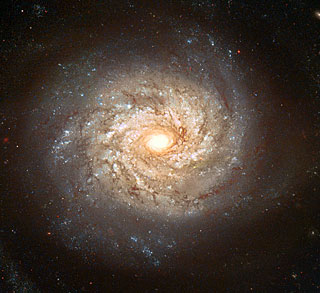 - If you see a supernova, it could be your big moment in life? NASA photos.
The Milky Way use to be thought of as a spiral galaxy, but recently collected data seems to suggest to astronomers that the Milky Way could in fact be a barred galaxy. Either way, the human journey to the beginning of the universe has revealed to astronomers a seeming infinity of galaxies beyond the celestial horizon we view from Earth. Spiral galaxies abound in amazing numbers in the universe, elliptical and barred galaxies have been viewed in endless numbers beyond the celestial horizon, and none of these galaxies look exactly the same. Beyond the horizon we view from Earth, the universe astronomers view goes on and on, without an end in sight, but everything we humans have experienced has an ending and beginning. Can the universe truly go on forever, or is it conceivable that somewhere beyond the celestial horizon there exists boundaries beyond which the known universe ends and another reality exists.
Astronomers using the Hubble Space Telescope recently journeyed to spiral galaxy NGC 3982 to look for clues to these questions and others that have fascinated humans since the time of the first star gazers. A face-on spiral galaxy first discovered by William Herschel on April 14, 1789, NGC 3982's spiraling arms are lined with pink star-forming regions of space and time glowing with hydrogen, newborn blue star clusters, and star dust capable of providing the raw material for future generations of stars. Astronomers believe hidden in the nucleus of NGC 3982 is a generation of older stars, which become more densely packed as the distance to the center of the nucleus of NGC 3982 lessens. NGC 3982 is an amazing 68 million light-years distant in the constellation Ursa Major and is currently speeding away from the center of the Milky Way Galaxy at a recession velocity of 1187 km/s. NGC 3982 is also a smaller spiral galaxy and spans about 30,000 light years, which is only about one-third the size of our own Milky Way Galaxy.
Astronomers are looking at spiral galaxy NGC 3982, and other similar galaxies, in the hopes of viewing a celestial event of amazing intensity and power, a supernova. They're currently using the instruments on the Hubble Space Telescope to look for a supernova in spiral and other galaxies, but soon the James Webb Space Telescope will add its star gazing ability to this job. They want to check current theories on how supernova occur and possibly the types of stars that end their lives in these spectacular explosions. Their search will be primarily in the bright blue knots in NGC 3982's spiral arms, but they'll certainly expand their search as the human journey to the beginning of the universe continues.
Posted by Warren Wong. Posted In : supernovas
November 5, 2010
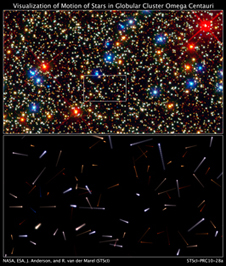 - The bottom photo reminds many of bees moving around in a hive. NASA photos
The Hubble Space Telescope takes the human journey to the beginning of the universe into the beehive
We join the human journey to the beginning of the universe as it boards the Hubble Space Telescope to travel 15,800 light years (~ 4850 parsecs) into Centaurus the Centaur to globular cluster Omega Centauri to peer into the beehive and look at individual stars.The beehive as it's called was first noted by early star-gazer Ptolemy 2,000 years ago, both the largest and brightest globular cluster orbiting the Milky Way, the beehive is about 12 billion years old. Ptolemy didn't have the Hubble Space Telescope to view Omega Centauri, so in his writings he refers to the beehive as a single star. In reality, the beehive, or Omega Centauri, is a tightly packed group of about 10 million stars held together by gravity, and orbiting a central gravitation mass, of some kind. In fact, the stars in the beehive are on average only about 0.1 light years apart, so close together that astronomers had to use the powerful vision of the Hubble Space Telescope to resolve individual stars.
 - The view from the Hubble Space Telescope
The Hubble Space Telescope's vision is so sharp astronomers have used the images they have collected over a four-year period of viewing globular cluster Omega Centauri to precisely measure the relative motions of over 100,000 individual stars in the beehive. In an effort to gain insight into the evolution and life cycle of tight groups of stars formed in the early universe, and try to determine if there's in fact an intermediate mass black hole hidden in the beehive. This study was conducted over a four-year period by Jay Anderson and Roeland van der Marel of the Space Telescope Science Institute using Hubble's Advanced Camera for Surveys and high-speed, sophisticated computer programs to measure the relative motions of individual stars in the beehive.On a clear night in the southern equatorial region of the night sky it's even possible to view the 3.5 magnitude beehive with the naked eye. Globular cluster Omega Centauri will appear as a fuzzy star that early astronomers believed was a single star. Use astronomical binoculars as your time-machine-to-the-stars, or a telescope, and the view becomes a wonder to behold as wide across in your view finder as the Full Moon. Using an 8-inch time-machine-to-the-stars you'll view about 1,000 stars, each a faint pinprick of light, and you should notice that the beehive isn't completely circular. Globular cluster Omega Centauri in fact rotates at a pretty fast speed around its central gravitational mass and astronomers believe this is one reason it's less than circular
Posted by Warren Wong. Posted In : Star Astronomy
November 4, 2010
 Photos NASA Photos NASA
Six exo-planets are circling red dwarf star Gliese 581 20 light years distant in the constellation Libra
The human search for an exo-planet capable of being a cradle for a new human genesis found what many consider to be the first exo-planet with the physical makeup to make it possible. A team of planet hunters from the University of California (UC) Santa Cruz and the Carnegie Institute of Washington recently announced to the world the discovery of an exo-planet they believe has a few characteristics of an exo-planet with the right stuff to make life possible. Gliese 581g, as it's referred too, has about three times the mass of Earth and appears to be situated in the right spot in the solar system of red dwarf star Gliese 581 for the ingredients of life to exist. This is about dead center in what planet scientists term the habitable zone of Gliese 581, a position planet scientist believe could make it possible for water and an atmosphere to exist on this exo-planet, necessary ingredients for the formation of life, planet scientists believe.
These planet hunters have been using one of the largest time-machine-to-the-stars on the planet, the Keck I Telescope in Hawaii's W.M Keck Observatory, to journey 20 light years to the constellation of Libra to continue the search for more planets circling red dwarf star Gliese 581 that could be habitable. Planet hunters have been using the HIRES spectrometer to precisely measure the radial velocity of the host star - the motion of the star along the line of sight from Earth - and stars close to red dwarf star Gliese 581, in order to try to find other planets circling this red dwarf star. The gravitational pull of orbiting planets causes periodic changes in the radial velocity of the host star that astronomers can calculate using sophisticated mathematical techniques we'll cover on another day. These are the techniques planet hunters used in order to find all of the stars they have found circling red dwarf star Gliese 581, which after the two most recent planet discoveries, brings the total to six exo-planets circling this distant star.
The discovery of six exo-planets circling red dwarf star Gliese 581 marks the high-planet mark for the human hunt for planets capable of being a cradle for a new human genesis. Gliese 581g is the only planet of the six exo-planets discovered that astronomers have indicated, so far, as being in the life zone of red dwarf star Gliese 581. This exo-planet orbits its parent star in about 37 days and measurements planet scientists have made of its mass indicates it's probably a rocky planet with a definite surface and enough gravity to hang onto an atmosphere. Gliese 581g is also tidally locked to its parent star, which means that one side of the planet is always facing its host star and in perpetual daylight. This makes some planet scientists believe that the best place for life to exist would be in the terminator, the part of the planet between the day and night sides of the planet.

Posted by Warren Wong. Posted In : Star Astronomy
November 1, 2010
 NASA photo NASA photo
Supernovas are some of the most powerful and visually striking events observed during the human voyage to the beginning of the universe. Releasing more energy in a single moment than Sol will over its entire lifetime, a supernova is luminous enough to shine brighter in the night sky than entire galaxies during one moment in space and time, before slowly fading from view over several weeks or months. The force of a supernova expels a large percentage of a star's mass into the darkness of space and time at about 10 percent of the speed of light, and creates a shockwave that sweeps up the expanding shell of gas and dust released during the explosion referred to by astronomers as a supernova remnant.
Astronomers using NASA's Spitzer Space Telescope to search the night sky for active galactic nuclei (AGN), super-massive black holes at the center of galaxies, recently reported the discovery of a supernova smothered in the remnants of its own star-dust during their search. This has astronomers scratching their heads in amazement at something they have never viewed during the human journey to the beginning of the universe. Scientists think supernovas like this one probably occurred during the early universe, more than they do during present time, and this discovery has astronomers looking for answers to questions they never thought they would be asking.
The recorded temperature of the object they were viewing was about 1,000 Kelvin (about 700 degrees Celsius), which is slightly hotter than the surface of Venus. This means something was dissipating the light energy of the supernova as heat? Astronomers wondered if the dust from the supernova could be choking off the light from the supernova and creating the heat they were viewing? Taking data from studies of NASA's Spitzer Space Telescope astronomers worked backward in space and time to see if they could figure out what kind of star could have theoretically created this supernova and if they could recreate a scenario where the dust from a supernova obscures the universe from the light released during the supernova. They calculated that the star in this supernova would have to be a giant star at least 50 times as massive as Sol. Astronomers have viewed these types of stars releasing huge clouds of dust as they near the end of their lives, but they calculated this particular star probably released clouds of star-dust several times during this same period of time. The last cloud of star-dust expelled would therefore be closer to this massive star, than earlier released clouds of star-dust, they reasoned. If the earlier dust cloud was also opaque, it would absorb the light energy released during later energy releases, and this could certainly account for the hot dust cloud they observed through NASA's Spitzer Space Telescope.
Posted by Warren Wong. Posted In : Star Astronomy
|
Author
Warren Wong
Prince George, British Columbia.
|
















 Photos NASA
Photos NASA
 NASA photo
NASA photo